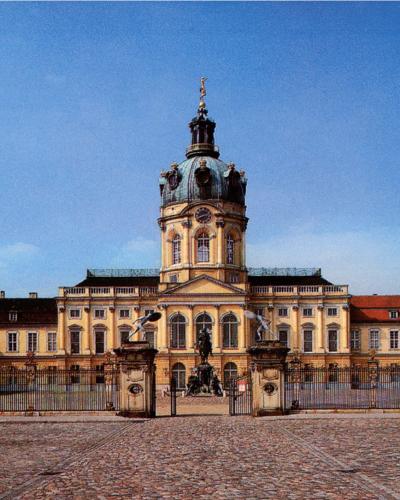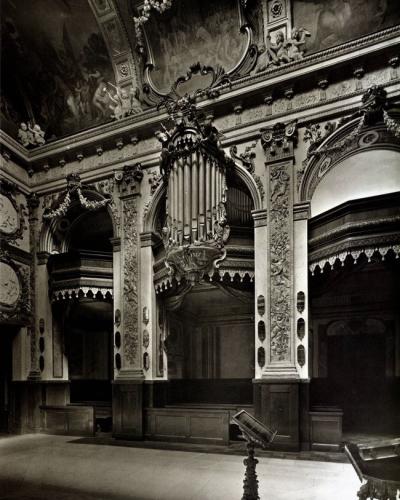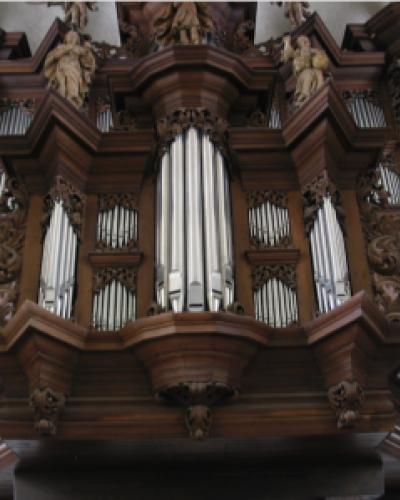Cornell’s Baroque Organ is a testament to the 21st-century builders who transplanted Arp Schnitger’s early 18th-century tonal world from Berlin to Ithaca, NY. The organ represents both a fascination with the past and a desire to build an instrument suited for a modern research university. Find out more here about the instrument(s) that inspired Munetaka Yokota and his team, and how the “fantasy reconstruction” arrived in Anabel Taylor.
Charlottenburg Palace, Berlin, 1706
The organ that provided the inspiration for Cornell’s Baroque organ was built in 1706 by Arp Schnitger, and was designed for the chapel of Schloss Charlottenburg, the new palace of King Frederick I of Prussia. Schnitger was known for his ability to build organs in awkward spaces, and the Charlottenburg chapel was indeed unusual, allowing for only a very small visible façade concealing a much larger instrument. Built with haste so as to be ready for the wedding of Prince Friedrich Wilhelm, the organ met with royal approval, and Schnitger was awarded the title of “Royal Prussian Organbuilder” two years later. The organ remained virtually unchanged for much of its history, with the exception of the alteration of two reed ranks, made ahead of a royal wedding in 1888. That it stayed intact for so long is witness to Schnitger’s novel tonal design, which both played to tradition and included some experimentation. Although much of the instrument was inspired by the North German style––with its strident choruses across multiple divisions, popularized by Schnitger in the grand Hanseatic cities of Hamburg and Lübeck––the Charlottenburg organ also included several experimental wooden ranks, and represented a synthesis of northern and central German styles. The wooden, delicate flutes (the HW and RP floite dues) and the string stop, the Viol de Gamb (HW), alongside two wooden ranks in the pedal, meant the instrument could function as a chamber instrument in the company of other musicians in a royal chapel, both performing the most fashionable styles and accompanying a congregation.
Rediscovery, Recordings, and Destruction
The Charlottenburg Organ enjoyed a renaissance in the late 1920s, when it was rediscovered by architectural historian Bodo Ebhardt and organist Wolfgang Auler. Essentially untouched from its 18th-century construction, the organ went on to inspire some of the efforts of the early German Organ Reform movement (the Orgelbewegung), which embraced the aesthetics of the past, calling for a return to an earlier “purity” of organ sound that rejected the “excesses” of romantic instruments. Schnitger’s Charlottenburg organ provided an iconic sound for the movement, with important scholars and organists such as Fritz Heitmann and Walter Kaufmann immortalizing the instrument in recordings, writings, and performances. That this inevitably became tangled with Nazism is a tragic part of the Charlottenburg organ’s history. In 1943, Schloss Charlottenburg and its organ became one of many iconic Berlin buildings to be destroyed by Allied bombers.
Anabel Taylor Chapel, Ithaca, NY, 2010
The instrument in Charlottenburg itself was rebuilt by Karl Schuke in 1965, using information he had recorded during his care of the organ immediately before WWII. At the turn of the 21st century, however, it would receive another unexpected lease of life, across the Atlantic in Ithaca, NY. The organ built under the direction of Munetaka Yokota for Anabel Taylor Chapel is not a replica of the Charlottenburg organ, but rather, in the words of Given Foundation Professor in the Humanities and University Organist Annette Richards, “a fantasy reconstruction” of the instrument Schnitger might have built for the space. The tonal design reimagines the Charlottenburg instrument for Cornell’s similarly small chapel, while the case, with no constraints of space in Ithaca (unlike Berlin) is inspired by another Schnitger instrument of 1702, at Clausthal-Zellerfeld. The work is the result of an international collaboration that spanned continents, with Yokota overseeing a project that encompassed scholars, physical scientists, musicians, craftsmen, and visual artists from Sweden (in particular the GOArt center at Göteborgs Universitet), Japan, The Netherlands, Germany, and the US, including volunteers from the local community. Ithaca-based master woodworkers Christopher Lowe and Peter De Boer built the case entirely by hand, and the Canandaigua-based Parsons Pipe Organ Builders built the wind system, key- and stop- action using 18th-century techniques taught by Yokota. Further connecting Cornell’s Baroque Organ to its Berlin ancestor, Yokota was inspired as a teenager by coming across a record that reconstructed a 1933 recording made on the Charlottenburg organ; a vibrant, striking sound that inspired Yokota to pursue a career as an organ builder.
Annette Richards on why Cornell University built its Baroque Organ
Annette Richards discusses the design of the Baroque Organ, after Arp Schnitger
Reflections on a completed project
Herbert Gussman Professor of Music, David Yearsley, wrote two connecting pieces reflecting on the work of Munetaka Yokota, and the rebirth of the Charlottenburg organ at Cornell. Find these short reflections here and here.




